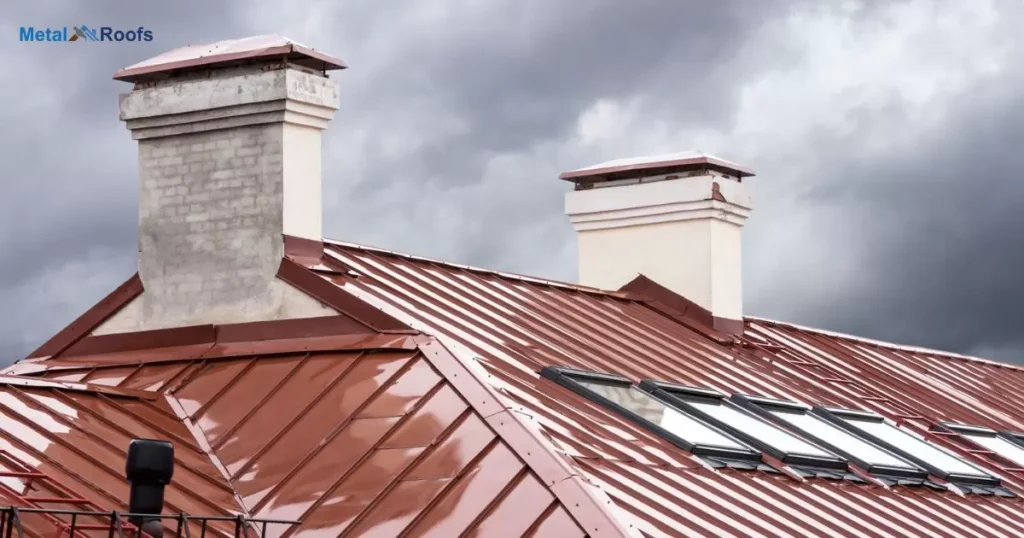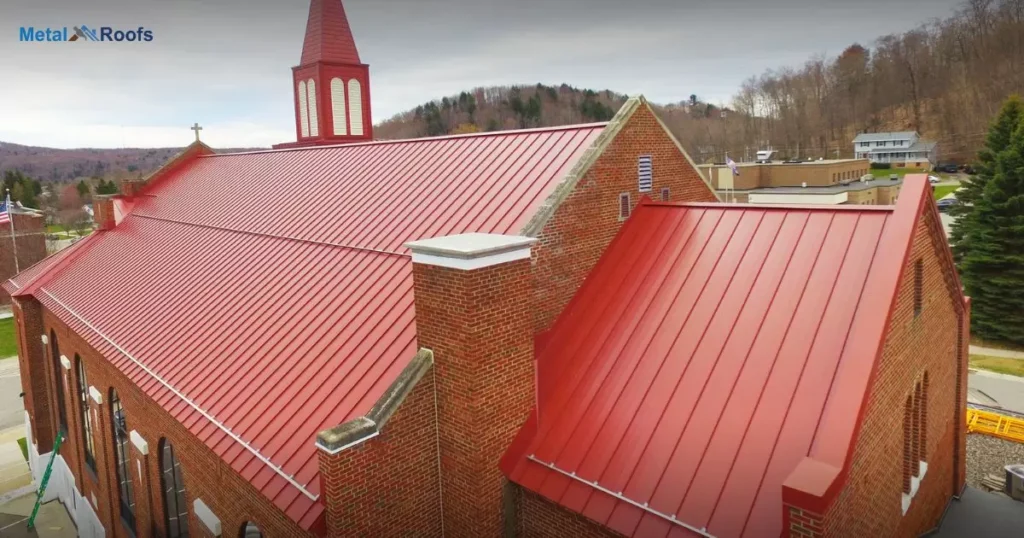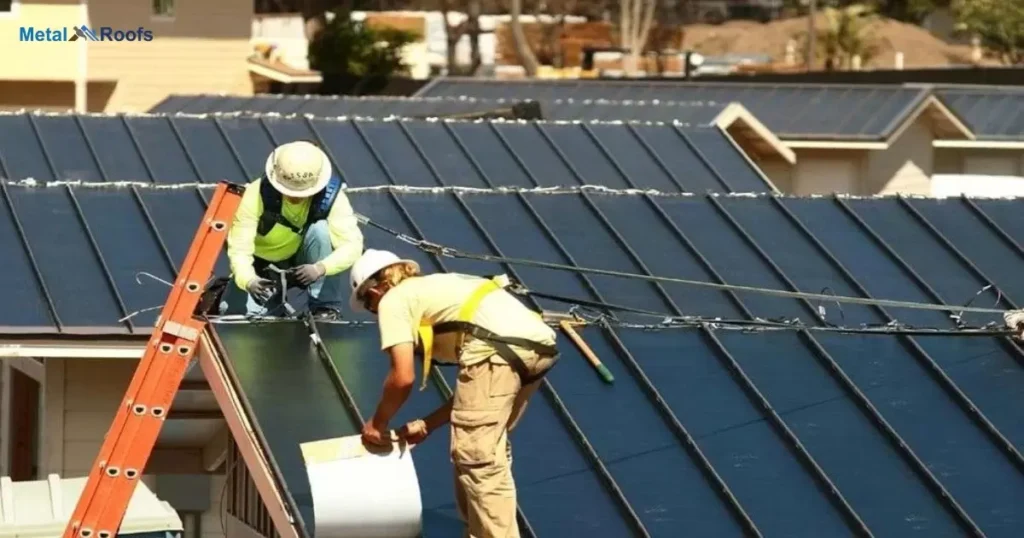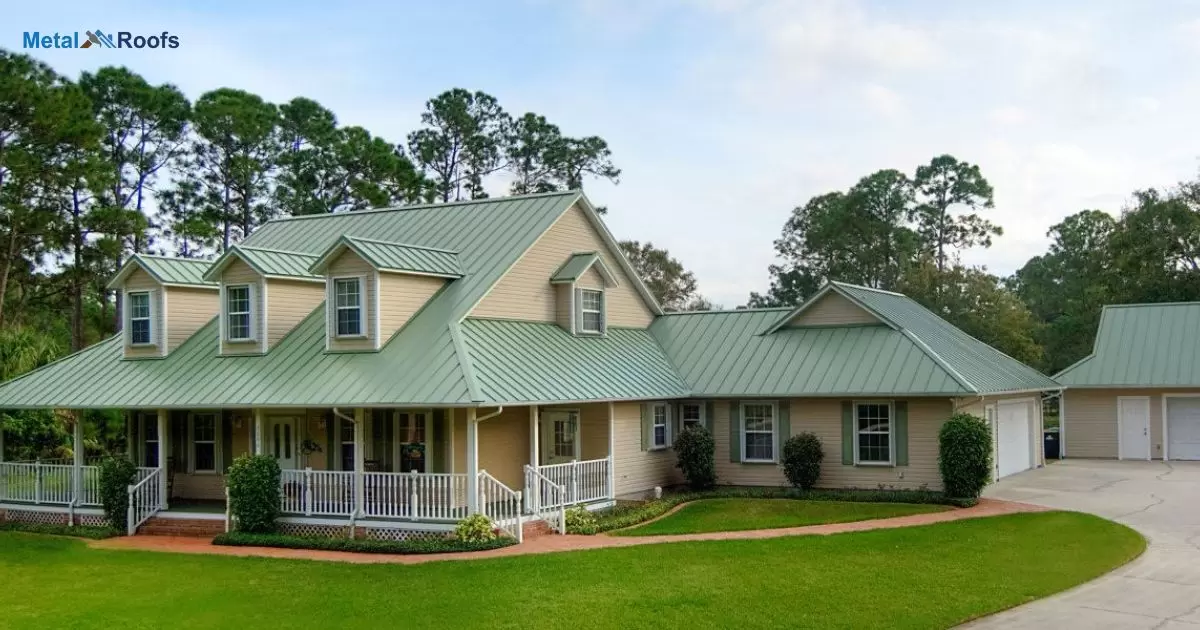Metal roofs absorb and hold heat. They get very hot in the sun. This makes homes hotter inside. Proper insulation can help a bit. But metal roofs still make it warm. Cool roofs reflect more sunlight. They can keep homes cooler inside. Metal roofs raise energy costs too.
metal roofs trap heat inside homes. do metal roofs make house hotter? not really. they reflect sun’s rays. proper attic insulation is key. metal roofs offer energy efficiency. consider all factors before deciding.
Our main topic is complex, including metal roofs be painted. Thorough analysis is required, with clear examples aiding our study. Keeping an open mind, moving step-by-step, and checking assumptions are vital.
Key Takeaways
- Metal roofs reflect sunlight, keeping houses cooler.
- They have ventilation systems for heat dissipation.
- Generally, metal roofs don’t make interiors hotter.
- They’re more effective at cooling than asphalt shingles.
- Proper installation is key for maximum benefits.
Metal Roof Heat
Metal roofs reflect sunlight and heat away from your home, which helps keep it cooler during hot weather. Unlike asphalt shingles, metal doesn’t absorb as much heat, reducing the amount of warmth transferred inside. Metal roofs often come with ventilation systems that allow heat to escape efficiently.
While metal roofs can feel warm to the touch in sunlight, they typically don’t make your house hotter overall. In fact, they can contribute to better energy efficiency by reducing the need for air conditioning. Overall, metal roofs offer a smart choice for maintaining a comfortable temperature in your home while also providing durability and longevity.
Does A Black Metal Roof Make Your House Hotter?
| Factors | Impact on Heat |
| Color Absorption | Black absorbs more heat |
| Reflective Coatings | Reflective coatings reduce heat absorption |
| Ventilation | Proper ventilation helps reduce heat buildup |
| Insulation | Good insulation keeps interior cooler |
| Radiant Barrier | Radiant barrier blocks heat transfer |
| Roof Design | Design features can enhance cooling effects |
A black metal roof can absorb more sunlight than a lighter-colored one. This absorption may make the roof feel hotter to the touch during sunny days. However, the impact on the interior temperature of your house is limited. Metal roofs reflect much of the heat away from your home, helping to keep it cooler inside.
So, while a black metal roof might feel warmer outside, it typically doesn’t significantly increase the temperature inside your house. In fact, metal roofs can even contribute to energy efficiency by reducing the need for air conditioning during hot weather.
Metal Roofs Reflect Heat

Metal roofs reflect heat, which helps keep your house cooler. Unlike asphalt shingles, metal doesn’t soak up the sun’s rays. Instead, it bounces them back into the atmosphere. This reflective property reduces the amount of heat that enters your home.
As a result, your house stays more comfortable during hot weather. Metal roofs often have ventilation systems. These systems let hot air escape, further cooling your home. Overall, metal roofs not only provide durability but also help maintain a cooler indoor environment.
Metal Roofs Make House Hotter In Summer
Metal roofs, contrary to common belief, do not contribute to higher indoor temperatures during the summer months. They reflect sunlight rather than absorbing it, which helps to keep the interior of the house cooler. This is unlike traditional asphalt shingle roofs, which can absorb and retain heat, leading to warmer indoor temperatures.
Metal roofs often come with ventilation systems that facilitate the escape of heat, further mitigating any potential increase in indoor temperature. Although metal roofs may feel warm to the touch when exposed to direct sunlight, their reflective properties and ventilation mechanisms prevent them from significantly impacting the overall temperature inside the house.
Do Metal Roofs Make House Hotter In Winter?
Metal roofs can actually help keep your house warmer in winter. Unlike traditional roofing materials, metal roofs reflect less heat from inside your home, helping to maintain a cozy temperature. Metal roofs are excellent at shedding snow, preventing heavy buildup that can lead to heat loss and structural damage.
With proper insulation, metal roofs can act as a barrier against cold air, keeping your home more comfortable during the chilly months. So, if you’re looking to stay snug when the snow falls, a metal roof might be the way to go.
Disadvantages Of Metal Roofs

While metal roofs have numerous advantages, they also come with some disadvantages, including:
Cost: Initially, metal roofs can be more expensive to install compared to traditional asphalt shingle roofs. The materials themselves are often pricier, and the installation process may require specialized skills.
Noise: During heavy rain or hailstorms, metal roofs can be noisy, which some people find bothersome. This can be mitigated by proper insulation or choosing thicker metal panels.
Denting: While metal roofs are durable, they can dent if struck by large hailstones or heavy objects. This may not affect the functionality of the roof but can affect its appearance.
Expansion and Contraction: Metal expands and contracts with temperature fluctuations. If the roofing panels are not properly installed with room for expansion and contraction, it can lead to buckling or warping over time.
Compatibility with Other Materials: Some types of metal roofs may not be compatible with certain types of insulation or other roofing materials, which can limit design and construction options.
Color Fading: Over time, the color of painted metal roofs may fade due to exposure to sunlight and other environmental factors. While this doesn’t affect the performance of the roof, it can impact its aesthetic appeal.
Repair Difficulty: While metal roofs are generally low maintenance, repairing them can be more challenging than repairing traditional asphalt shingle roofs.
Despite these disadvantages, many homeowners still find that the benefits of metal roofs, such as longevity, energy efficiency, and durability, outweigh these drawbacks.
Black Metal Roof Pros And Cons
A black metal roof has its pros and cons. On the positive side, it looks sleek and modern, enhancing your home’s appearance. It’s durable, lasting 50 years or more, and requires minimal maintenance. It’s fire-resistant, which adds a layer of safety to your house.
Additionally, metal roofs are eco-friendly, often containing recycled materials. There are drawbacks. Black metal roofs can absorb heat, potentially making your home warmer in hot climates. They can also be more expensive upfront compared to other roofing materials.
How Metal Roofs Affect Temperature?
Metal roofs reflect sunlight, keeping homes cooler. They don’t absorb heat like asphalt shingles. Also, they often have ventilation systems for better airflow. So, they help maintain a comfortable temperature inside.
Thermal Conductivity Of Metal
Metal conducts heat efficiently. This means it transfers heat quickly. In summer, metal roofs can get hot. But with proper insulation, heat transfer reduces. This helps maintain cooler indoor temperatures.
Heat Absorption And Reflection
Metal roofs absorb and reflect heat. Light colors reflect sunlight well. This keeps homes cooler. Dark colors absorb more heat. Choose wisely for better comfort.
Impact On Indoor Temperature
Metal roofs can impact indoor temperature. Reflective surfaces keep homes cooler. Proper insulation prevents heat gain. Ventilation allows hot air to escape. These factors ensure comfort.
Factors Influencing Temperature

Temperature is affected by various factors. Sunlight exposure directly influences heat levels. Building materials, such as metal roofs, can reflect or absorb heat. Ventilation systems help regulate internal temperatures.
Orientation And Sun Exposure
Orientation and sun exposure affect roof temperature. South-facing roofs get more sun. East and west-facing roofs get sun at different times. North-facing roofs get the least sun. Orientation impacts how much heat your roof absorbs.
Insulation And Ventilation
Insulation keeps your home warmer in winter and cooler in summer. Proper ventilation prevents heat buildup and maintains air quality. Together, they play a crucial role in regulating your home’s temperature.
Climate And Regional Variations
Climate and regional variations greatly impact temperature. Coastal areas often have milder temperatures due to ocean influence. Inland regions tend to experience more extreme temperature changes. Elevation also plays a role, with higher altitudes typically being cooler.
Frequently Asked Questions
How Much Hotter Is It On A Metal Roof?
Metal roofs feel warm in sunlight but don’t heat up homes much. They reflect sunlight and vent heat, keeping interiors comfortable. So, while they’re warm outside, they won’t roast you indoors.
How Do You Cool A House With A Metal Roof?
To cool a house with a metal roof, insulate underneath, ventilate the attic, use light-colored roofing, and consider radiant barriers or cool roof coatings.
How Do You Reduce Heat On A Metal Roof?
Choose light colors, use reflective coatings, ensure insulation, and install ventilation to reduce heat on a metal roof.
Conclusion
Metal roofs help keep homes cooler. Their reflective nature reduces heat absorption. Proper insulation and ventilation aid in maintaining a cool interior. Choose light colors for better heat reflection. Apply reflective coatings for extra protection.
With these methods, metal roofs prove effective. They offer a durable and energy-efficient option. Stay cool and comfortable with a well-prepared metal roof. Make informed choices for better home comfort. Enjoy the benefits of a cooler home.











